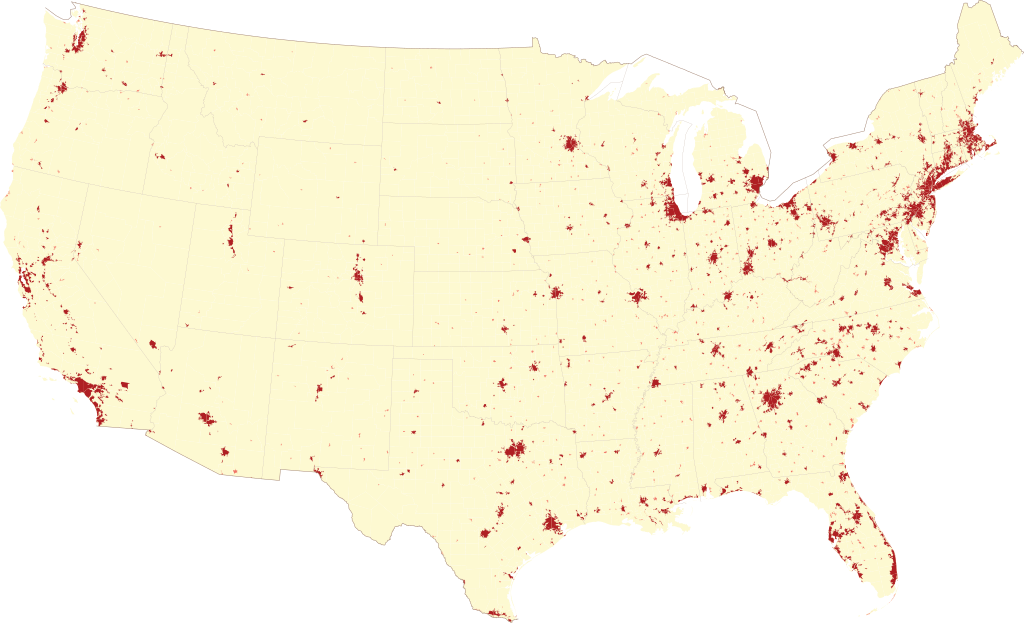Quote:
Originally Posted by Hindentanic

Another strategy for ranking U.S. cities by population or density without the skew of political, municipal, or metropolitan borders incorporating vast swaths of empty area is by treating them as Urban Areas as defined by the U.S Census. Urban areas are constructed from contiguous census block groups that meet a minimum density threshold (Wikipedia says 1,000 per square mile), and can further be defined as an "urban cluster" if the total population is greater than 2,500 or as an "urbanized area" is the total population is greater than 50,000. The census block groups themselves are comprised of an average of 39 census blocks, with each census block often corresponding to a street-defined city block.
A defined Urban Area map for the U.S. corresponding to the 2010 Census is below, with the actual urban areas of threshold-meeting contiguous census block groups in red:

(From Wikipedia: USA Urban Areas)
A much larger size map is here.
This is a much better match to significant, physically built-up areas, and does not involve metro areas that absurdly incorporate empty deserts, mountain ranges, or unpopulated swaths of whole states. It's imperfect, as opinions regarding where to peg the threshold between "urban" and "rural" vary, but this offers a definable and measurable governmental standard upon which we can make more rational and coherent comparisons.
A Wikipedia listing for 2010 U.S. urban areas with statistics for area, population, and density is here: List of United States urban areas
You have to start hunting through census projections to get more current estimates to construct up-to-date maps, but they can be found. I recall that similarly compiled urban area census information can be obtained for Canada and Japan, and very likely for most of world, though the defined thresholds and levels of granularity will vary.
CityLab in 2012 offered a critique of this approach along with insightful user commentary: " U.S. Urban Population is Up...But What Does 'Urban' Really Mean?" |
Here is the list from the link you posted...
This is the top 20 list of urban areas ranked by population.
Urban areas of the United States of America[1]
Rank Name[Note 1] Population Land Area Land Area Density Density Central City Central City Central City Central City
(2010 Census) (km²) (sq mi) (Population / km²) (Population / sq mi) Population Pop % of Land Area Land Area % of
(2010 Census) Urban Area Urban Area
1 New York--Newark, NY—NJ—CT-PA 18,351,295
2 Los Angeles--Long Beach--Anaheim, CA 12,150,996
3 Chicago, IL—IN—WI 8,608,208
4 Miami, FL 5,502,379
5 Philadelphia, PA—NJ—DE—MD 5,441,567
6 Dallas--Fort Worth--Arlington, TX 5,121,892
7 Houston, TX 4,944,332
8 Washington, DC—VA—MD 4,586,770
9 Atlanta, GA 4,515,419
10 Boston, MA—NH—RI-CT 4,181,019
11 Detroit, MI 3,734,090
12 Phoenix--Mesa, AZ 3,629,114
13 San Francisco--Oakland, CA 3,281,212
14 Seattle, WA 3,059,393
15 San Diego, CA 2,956,746
16 Minneapolis--St. Paul, MN 2,650,890
17 Tampa--St. Petersburg, FL 2,441,770
18 Denver--Aurora--Lakewood, CO 2,374,203
19 Baltimore, MD 2,203,663
20 St. Louis, MO—IL 2,150,706
This is the list of the 20 largest urban areas sorted by density.
Urban areas of the United States of America[1]
Rank Name[Note 1] Population Land Area Land Area Density Density Central City Central City Central City Central City
(2010 Census) (km²) (sq mi) (Population / km²) (Population / sq mi) Population Pop % of Land Area Land Area % of
(2010 Census) Urban Area Urban Area
Rank Name[Note 1] Density
(Population / sq mi)
Los Angeles--Long Beach--Anaheim, CA 6,999.30
San Francisco--Oakland, CA 6,266.40
New York--Newark, NY—NJ—CT-PA 5,318.90
Miami, FL 4,442.40
San Diego, CA 4,037.00
Denver--Aurora--Lakewood, CO 3,554.40
Chicago, IL—IN—WI 3,524.00
Washington, DC—VA—MD 3,470.30
Phoenix--Mesa, AZ 3,165.20
Baltimore, MD 3,073.30
Seattle, WA 3,028.20
Houston, TX 2,978.50
Dallas--Fort Worth--Arlington, TX 2,878.90
Detroit, MI 2,792.50
Philadelphia, PA—NJ—DE—MD 2,746.40
Minneapolis--St. Paul, MN 2,594.30
Tampa--St. Petersburg, FL 2,551.50
St. Louis, MO—IL 2,328.50
Boston, MA—NH—RI-CT 2,231.70
Atlanta, GA 1,706.90



